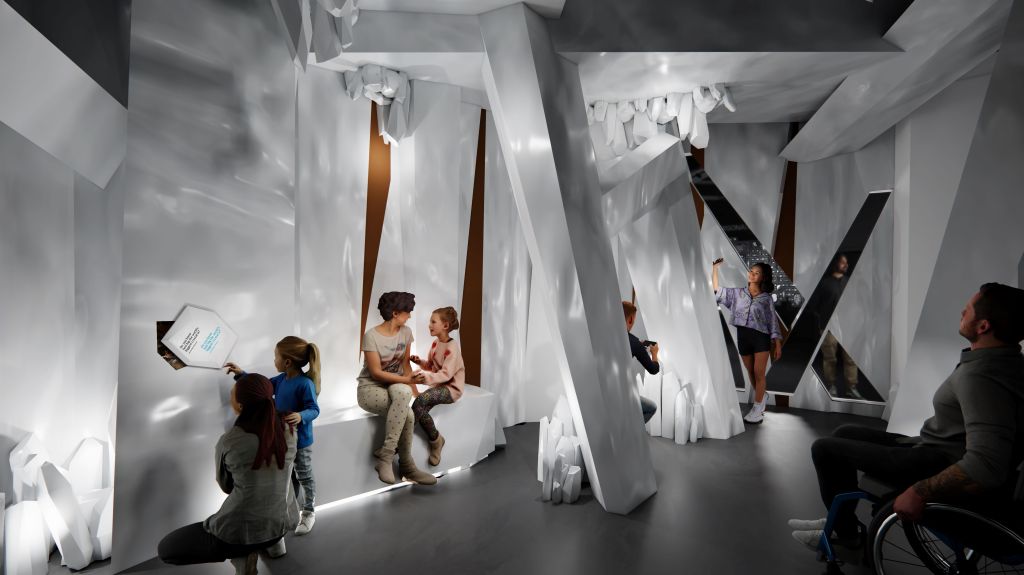The Gems and Minerals Hall has seen a lot of change since it debuted at the Denver Museum of Nature & Science 43 years ago — though not nearly as much as its sparkly specimens have seen over their own geological timescale of hundreds of millions of years.
One of the newest events on the timeline: a $30 million, 18-month renovation and expansion project that begins next year. The project will add 50% more space for the permanent exhibition and fundamentally rethink how visitors, especially kids, interact with the hall’s thousands of sapphires, quartz, rubies, emeralds, garnets and diamonds.
Still, change can be hard, especially at a museum. “One of the things we heard when we spoke to the community was, ‘You need to keep this or that exhibit, because it’s where I had my first kiss or my first date,’” said museum project lead Luke Fernandez.
“We respect the nostalgia people may have, and are honoring that by repurposing a couple of the most popular elements of the old hall into the new design,” he added. Those are the Sweet Home Mine, which shows off the red rhodochrosite crystals mined in Colorado, and the Crystal Grotto, which resembles the inside of a natural cave.”
The new parts of the exhibit will focus on immersive features such as an interactive state map of mineral deposits; a Mineral Mart mock convenience store that teaches about the daily role of minerals in our lives; a Color Room with more than 250 fluorescing minerals that “transform under changing ultraviolet light conditions”; a Gem Journey that traces the raw-mineral-to-finished-gemstone path (featuring the museum’s largest faceted mineral, the Dali Topaz, a 10,588-carat gemstone); never-before-displayed specimens; and the world-renowned Hero Specimens, such as Diane’s Pocket, the Alma King and Campion Gold.
“When we think about museum-goers and guests from the 1980s, they really would just go to see things — that type of absorption of information. But (today’s) museum guests really want to get more engaged and have more hands-on learning,” said Jeff Joplin, the museum’s vice president of operations. “We want them to be able to learn about what’s happening beneath our feet every day, because the average American uses about 20,000 pounds of minerals per year.”
Only one other permanent exhibit at the museum, the life-sized wildlife dioramas, predates the 1982 launch of the gems and minerals section, which makes sense because of Colorado’s mining history. Currently sponsored by Coors, the exhibit will be renamed The Dea Family Gems & Minerals Hall after it reopens in 2027, following a “transformative” donation by longtime museum supporters Peter and Cathy Dea, the museum said.
Fernandez declined to name the donation amount, but said Peter’s career as a geologist, and his longtime board service at DMNS, give him and Cathy a strong connection to the new exhibit — even if they don’t have a direct say in its design and specimen selection.
“As a geologist, I naturally gravitate to the gems and minerals displays, and we are excited for this new experience to spark guests’ curiosity and imagination and inspire children’s enjoyment of science,” Peter Dea said in a press statement.
The 50% expansion will be accommodated by newly freed-up space on the City Park institution’s first floor, Joplin said. The design phase of the project started in 2023 but was accelerated by the Dea’s gift. A fundraising campaign to make up the remaining 22% of its $30 million price tag (or about $6.6 million) is ongoing, he added.
The current gallery will close for renovation at the beginning of 2026 and will remain off-limits to visitors for about a year and a half. Some of that time will be used to clean and reorganize the specimens, which aren’t always as sturdy as they may seem, Fernandez said.
“I know they’re old and I know they’re rocks, but you’d be surprised at how brittle they can be,” he said. “We have a very pointy, sea-urchin type specimen that’s brilliant with thousands of these crystals coming off of it. It’s extremely delicate and over time can degrade.”
How much time? Fortunately, far longer than the museum needs to renovate its exhibit — give or take a few million years.
Subscribe to our weekly newsletter, In The Know, to get entertainment news sent straight to your inbox.


